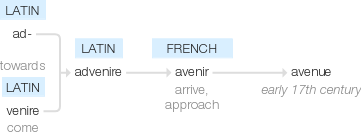Avenue
early 17th century (in avenue (sense 2)): from French, feminine past participle of avenir ‘arrive, approach’, from Latin advenire, from ad- ‘towards’ + venire ‘come’.
wiktionary
Borrowed from French avenue, from Old French avenue, feminine past participle of avenir(“approach”), from Latin adveniō, advenīre(“come to”), from ad(“to”) + veniō, venīre(“come”).
etymonline
avenue (n.)
c. 1600, "a way of approach" (originally a military word), from French avenue "way of access" (16c.), from Old French avenue "act of approaching, arrival," noun use of fem. of avenu, past participle of avenir "to come to, arrive," from Latin advenire "to come to, reach, arrive at," from ad "to" (see ad-) + venire "to come" (from a suffixed form of PIE root *gwa- "to go, come").
The meaning was extended to "a way of approach to a country-house," usually a straight path bordered by trees, hence, "a broad, tree-lined roadway" (1650s), then to "wide, main street" (by 1846, especially in U.S.). By late 19c. in U.S. cities it was used to form the names of streets without reference to character.
